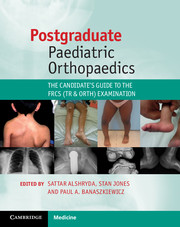Book contents
- Frontmatter
- Contents
- List of contributors
- Foreword
- Preface
- Acknowledgements
- Interactive website
- List of abbreviations
- Section 1 General guidance
- Section 2 Core structured topics
- Chapter 3 The hip
- Chapter 4 The knee
- Chapter 5 The foot and ankle
- Chapter 6 The spine
- Chapter 7 The shoulder
- Chapter 8 The elbow
- Chapter 9 Congenital hand deformities
- Chapter 10 Neuromuscular diseases
- Chapter 11 Musculoskeletal infections
- Chapter 12 Musculoskeletal tumours
- Chapter 13 Skeletal dysplasia
- Chapter 14 Metabolic bone disease
- Chapter 15 Physis and leg length discrepancy
- Chapter 16 Deformity corrections
- Chapter 17 Miscellaneous paediatric conditions
- Section 3 Exam-related material
- Index
- References
Chapter 16 - Deformity corrections
Published online by Cambridge University Press: 05 August 2014
- Frontmatter
- Contents
- List of contributors
- Foreword
- Preface
- Acknowledgements
- Interactive website
- List of abbreviations
- Section 1 General guidance
- Section 2 Core structured topics
- Chapter 3 The hip
- Chapter 4 The knee
- Chapter 5 The foot and ankle
- Chapter 6 The spine
- Chapter 7 The shoulder
- Chapter 8 The elbow
- Chapter 9 Congenital hand deformities
- Chapter 10 Neuromuscular diseases
- Chapter 11 Musculoskeletal infections
- Chapter 12 Musculoskeletal tumours
- Chapter 13 Skeletal dysplasia
- Chapter 14 Metabolic bone disease
- Chapter 15 Physis and leg length discrepancy
- Chapter 16 Deformity corrections
- Chapter 17 Miscellaneous paediatric conditions
- Section 3 Exam-related material
- Index
- References
Summary
Introduction
A limb deformity can be defined as distortion from the normal form. Malalignment refers to loss of collinearity of the hip, knee and ankle. It is therefore possible to have a deformity without malalignment. Deformity and malalignment can lead to pain, abnormal gait, loss of function and cosmetic deformity. Accurate assessment of deformity, planning of correction and choice of the most appropriate management tool are the keys to success in managing these complex patients.
Our understanding of assessment and management of deformity has progressed significantly in the last century. In particular, the understanding of biomechanics of the musculoskeletal system aided by the development of sophisticated computerized gait analysis. The concept of distraction histogenesis was pioneered by Professor Gavriil Ilizarov. He used circular frames to treat non-unions by compression. He noted that bone had formed at a fracture site after distraction when one of his patients misunderstood the instructions and turned the nuts in the wrong direction, lengthening the fracture site rather than compressing it. He called this ‘distraction histogenesis’ and he subsequently used it for limb lengthening, for gradual correction of bony deformity and for bone transport to correct intercalary bone defects. Dror Paley deciphered the intuitive deformity assessment and planning performed by ‘Ilizarov’ surgeons, and developed an easy and systematic approach to understanding lower-limb deformity and planning treatment [1]. Dr Charles Taylor introduced the Taylor spatial frame, which is the external fixator most commonly used for deformity correction in the Western world.
- Type
- Chapter
- Information
- Postgraduate Paediatric OrthopaedicsThe Candidate's Guide to the FRCS (Tr and Orth) Examination, pp. 240 - 248Publisher: Cambridge University PressPrint publication year: 2014



